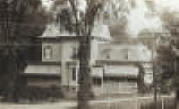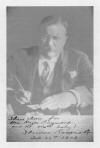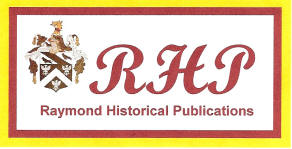|
|
|
Last time: We closed out the late post-Civil War years in Cambridge and America, from 1881-1900.
Chapter 20: The Curtain Rises on the 20th Century: 1901-1910 As the footlights came up on Act One of the 20th century, the United States of America—all 45 states plus a handful of western territories and offshore possessions—found itself on the stage of a new world order and began to assume global leadership. More on that later. First, though, to round out today’s lower 48, statehood was achieved in 1907 by Indian Territory, aka OK, and New Mexico and Arizona followed suit exactly one hundred years ago. Alaska and Hawaii, of course, added stars to Old Glory at mid-century. Incidentally, in a nod to the fact that the Islands were populated, not only from atolls down-under, but also the British Isles by 1820, Hawaii’s is our state flag sporting Mother England’s Union Jack. Any of the 13 Colonies? No way. A generation after the Southern Rebellion was squelched, a decade past the last of the Indian Campaigns, the Gilded Age morphed into the Modern as the U.S. flexed its new industrial muscle. The Spanish War of ‘98-’99 was short and sweet, tossing autocracy from Cuba and the Philippines for a promise of democracy. Patriotism was at an all time high. The Union vets of the Grand Army of the Republic were received as heroes in their hometowns in their declining years, while the up-tempo of John Phillip Sousa’s 76 trombones and 110 cornets charged the air along Main streets and above bandstands on warm summer nights.
Here in Our Town Cambridge, President Charles Tingue (mayor) turned the desk over to Hiram Parrish in 1902. Other familiar names that filled Village roles then linking past to present—presidents, trustees, clerks, treasurers—included Henry Ackley, Fred LeGrys, James Robertson, and Ralph Weir. Cambridge’s signature architecture lining the business districts, some still standing, included two and three story red bricks of Hudson River clay (typically from Coeymans, just below Albany.) With God intertwined in town life, a dozen churches stretched—still do—from South Park, along Main to Coila, to the countryside. Victorian residences featured broad verandas with awnings then, like the George McKie home in 1901 (see photo). Today it’s the Cambridge Historical Society & Museum, a stone’s throw from the then one-year-old D&H station, long past its station in life. Another village icon, with ionic columns, the Rice Mansion, was built in ’03 by wheel-chair bound Jerome Bonaparte Rice across the street from his business. Village minutes included these tidbits: “Vandalism continues and there are now complaints about slot machines in the hotels and saloons.” (“I'm shocked! Shocked to find that gambling is going on in here!” – Captain Louis to Rick, Casablanca.) “Bicycles on the sidewalks and in the road after dark without proper lights are hazards to wagons driven too fast by intoxicated drivers.” The Cambridge PD, still afoot and on horseback, was on alert but surely relished the next big thing, the telephone. With some of the town electrified for a decade, in February 1900 permission was granted to Granville Telephone to put a switchboard in, to serve the Village offices. Commercial and domestic use as well, which only the well off could afford then. Voters authorized paving Main Street in 1901 for $10,000 but nothing happened. By ‘08 the cost had doubled, so a new vote, 164 to 135, called the whole thing off. Oyster shells covering the mud and dust were tried but horses and hoofs didn’t like the stuff. Another way to get around town was conceived in ‘02, a trolley line, and while Bennington and Hoosick Valley RR Co. got a permit, this plan also vanished. Another proposal did take hold when village church bells were first enlisted for fire alarms. Yet another bright idea was offered to the Village Board in 1906: underground electric and telephone lines were suggested, but this too was kicked under the carriage, probably a good thing because the day’s technology wasn’t up for reliable service in the face of burrowing and gnawing critters. Down in D.C. during the early 1900s, interest was rekindled for a canal across the Isthmus of Panama, a project that failed the French a few decades prior when tropical diseases decimated the work crews. In 1903 this northern state of sovereign Columbia proclaimed independence, with no little help from the U.S. Navy. The new Panamanian government eagerly signed a 99-year treaty with Washington to establish the Canal Zone, and provide local jobs! It granted us “sovereign” rights in a region 10 miles wide by 50 miles across to build a canal, then administer and defend it “in perpetuity.” The father of a future Village resident—Army engineer Robert R. Raymond (1871-1944) who’d move to Cambridge in 1920—his father was on the short list considered to head the project. But Col. Charles W. Raymond (1842-1913) begged off due to declining health yet offered support for his friend Col. George Washington Goethals. Digging and damming began in 1904 with construction of lakes and locks lasting a decade. But not before malaria and yellow fever were defeated by American medicine including use of quinine, a natural alkaloid with fever-reducing, pain-killing, anti-inflammatory properties. The 99-year deal? Jimmy Carter gave it away in the ‘70s and China basically took over. If Goethals were alive, he’d likely put the peanut farmer in a headlock and give him a good noogie. In 1903 the civilized world was abuzz with other dramatic news, this time from a desolate wind-swept sandbar along the Outer Banks of NC, a place called Kitty Hawk. The brothers Wright, down from their Ohio bike shop, fashioned gasoline-powered flight for a time and distance that put them in the books. Once again, man pivoted on an event as he’d done a century before when the steam-powered locomotive first took him faster than a horse could gallop. Men, and women, joined the birds for more than a buoyant float on air since one could now plane the friendly skies, climb and bank and dive upon invisible currents of wind. Soon though, this proved a source of steel rain with the birth of aviation warfare (one of Robert Raymond’s grandsons, John Burlingame, would pilot a WWII bomber over Germany.) On April 18, 1906 the San Andreas Fault slipped and the shaking and fires turned San Francisco into rubble and ashes. The Army was charged with aiding local lawmen to restore order and it instituted martial law across the Bay Area…which could twist today’s “constitutional scholars”, aka “community picnic organizers”, into knots. Captain Robert Raymond received orders to report from Fort Leavenworth to perform real community organizing. He led a team in erecting emergency facilities, cabins and tents, for relief crews and civilians displaced by the plate rupture. (He’d serve another 14 years, through WWI, then retire to Cambridge.) In 1907 news from Newport News, VA, was of the launch of America’s Great White Fleet. Sixteen battleships of the Atlantic Fleet were dispatched by President Theodore Roosevelt on a circumnavigation, from Dec ‘07 to Feb ‘09. The hulls were white, the Navy's peacetime scheme, with gilded scrollwork and banners of red, white and blue wrapped along the bows. The armada visited more than a dozen stateside and foreign ports that bore witness to the diplomatic and military resolve of Uncle Sam. Something about sailing softly but carrying big banks of 12-inch barrels. This early display of latent shock and awe announced that we had displaced England, Germany and France, and China and Japan as the world’s dominant sea power. Any questions? On February 18, 1909 at Washington Barracks, District of Columbia, a child was born. The next day, Major Robert R. Raymond stood in a reception line at the White House, unaccompanied by his wife Blossom. This was the official Farewell Reception of the then outgoing President Roosevelt. Asked the whereabouts of Mrs. Raymond, the major replied she was at home with a day-old infant. The following day a signed photograph was delivered to the Raymond quarters with a personal message penned in the lower border by the old boy himself, the Commander-in-Chief (see photo.) Charles Walker Raymond, named for his grandfather, would become a resident of Cambridge from 1920 until his death in 1989, and like his father and grandfather, a graduate of West Point and career soldier.
In prep for the USMA, Charley Raymond would receive his secondary education at Cambridge High, following in the footsteps of CHS graduates since at least 1893. From 1902-1910, 85 students satisfied graduation requirements, including Bertha Hatch and Leslie Wilbur in ’02; Oliver Perry and Josephine Rice in ’03; and Earl W. Maxson in 1904, who lost his life in WWI and whose name carries on with the Cambridge American Legion. Grace and Marian Robertson, Finley Shiland and eight others donned caps and gowns in 1905,as did William Lawton in ‘06 with seven classmates. In 1907 the 16th Annual CHS Commencement was held in Hubbard Hall on June 25 as class president Forrest Herrington joined valedictorian Jennie Quinn and seven others on stage to receive sheepskins. Miss Quinn’s speech was entitled “The Blessings of Discontent”, suggestive of the era’s new progressive movement, of investigative reporting, aka muckraking exposing harsh factory working conditions across the land. (Or was she just decades ahead of herself, telling the folks to buzz off?) The next year class president David Ashton, Mabel Ensign and five others shook the hand of Education Board President John L. Hunt, again on the Hubbard stage, on June 23, 1908. Valedictorian John Donnan, likely reflecting on the Army’s victory over Spain, the big ditch in Panama, and Navy battlewagons dropping anchor in far off ports, delivered his “America’s Military Genius”. That must have made the crowd wince—well, maybe a misguided malcontent or two. Eleven graduates in ’09 left the halls of CHS including Reitha Ford, Frank King and Delia Perry, who married Emery Clark and together had a farm in White Creek for decades (still there, run by the grandkids.) Delia’s son Malcolm Clark would become a Coast Guard officer in the late ‘40s and eventually the Commandant of the USCG Academy in Connecticut. To round out the 1900s at Cambridge High School, in 1910 Herman and Lois Hitchcock joined LeRoy Brownell, Mabel LeGrys and 12 others in receiving their HS diplomas. Thus began a tradition of academic excellence at CHS that, safely said, lives on today at Cambridge Central. As the Great White Fleet returned to its homeports, keels were laid for the commercial trans-oceanic trades with luxury liner firms laying bigger and bolder plans on the drawing table. However, at least two chilling encounters became legendary: in April 1912 with an iceberg off Newfoundland (HMS Titanic), and in May 1915 with a U-boat off Ireland (HMS Lusitania). The second would soon draw America into global war with the resolve “Yes, I am my brother’s keeper” (Gen 4:9); a resolve that liberated hundreds of millions; a resolve of American exceptionalism. And a resolve that rejects home grown appeasement and war protests by the ungrateful and unwashed: main media editors, Marxist teachers and professors, hygienically challenged dopers who trash city streets. Grieving Gold Star mothers are quite another demographic with legitimate voice; their sacrifices belong to the sacred trust that keeps our nation, the founders’ America, yet a beacon today for billions. (Through this series’ journey back to the Cambridge Patent of 1761, we’ve already taken the reader to 1911—Chapter IV, April 2011—so we’ll move forward to the mid-teens and beyond.) Next time: Chapter 21, The Great War and The Roaring 20s, 1915-1929 Sources: CCS Alumni Assn. website; Cambridge Historical Society & Museum; Cambridge Village Archives; Raymond family archives; the biographies of Gen. Charles W. Raymond (1842-1913) and Col. Robert R. Raymond (1871-1944) (Thomas M. Raymond © 2010.) (Contact the author at tmraymond4@gmail.com.) =============================================================================== (Font 10.5; word count 1982) =============================================================================== CAMBRIDGE HISTORY LIVES © 2012 Thomas M. Raymond

|
|
CAMBRIDGE HISTORY LIVES © 2011
|





